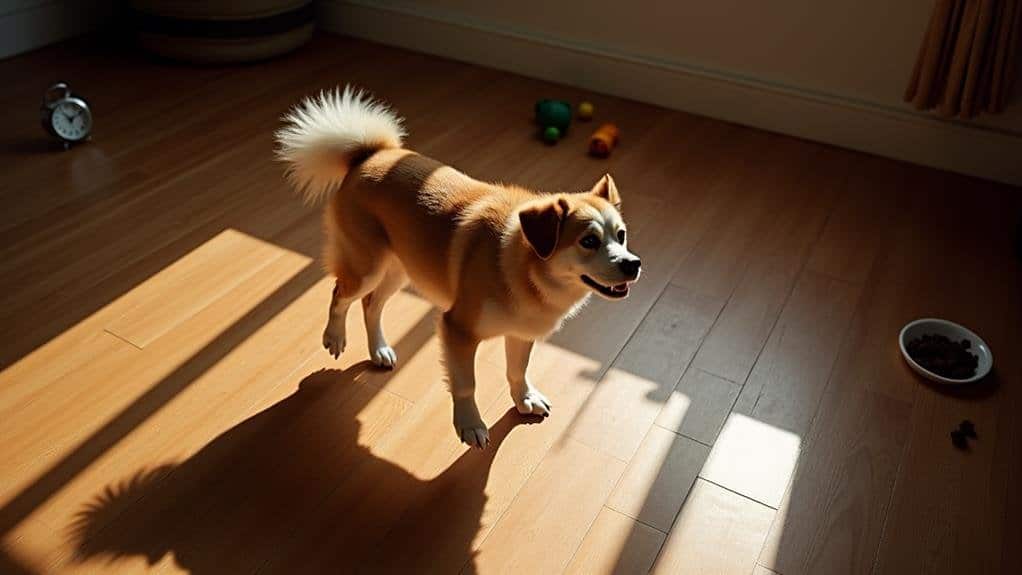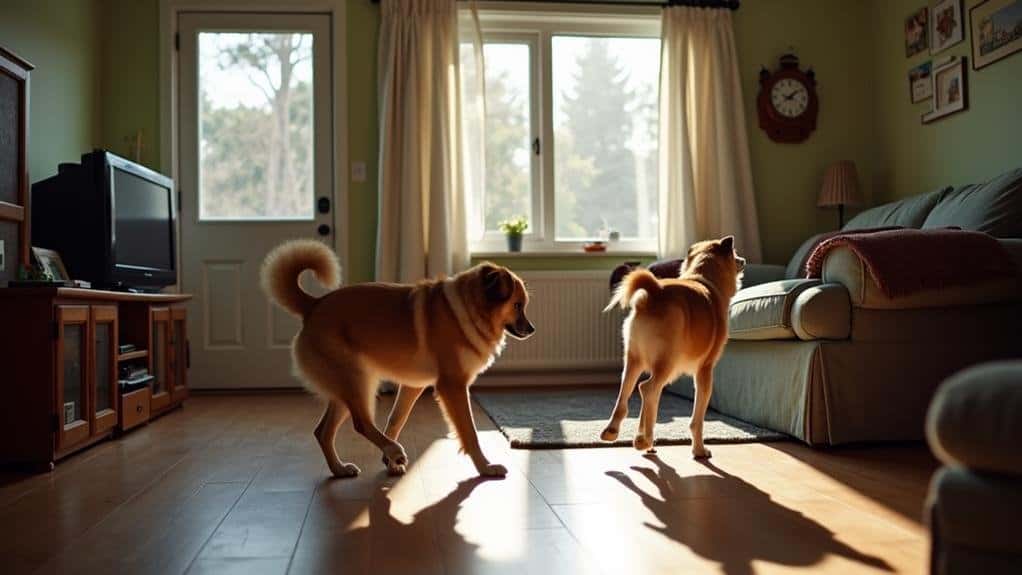Your dog's pacing could be caused by various factors. Anxiety and stress from loud noises or routine changes often trigger this behavior. Boredom due to lack of exercise or mental stimulation can also lead to restlessness. In older dogs, pain or discomfort from conditions like arthritis might be the culprit. Sometimes, neurological issues or age-related cognitive decline can cause pacing. Environmental factors, such as changes in surroundings or family dynamics, may contribute too. It's important to observe any accompanying symptoms and consider recent changes in your dog's life. Understanding the underlying cause is essential for addressing this behavior effectively.
Common Causes of Dog Pacing

While dogs may pace for various reasons, several common causes often explain this behavior. Anxiety and stress are frequent culprits, triggered by environmental factors like loud noises or changes in routine. You might notice your dog pacing alongside panting and vocalizing when they're feeling anxious.
Boredom is another significant cause of dog pacing. If your furry friend isn't getting enough physical and mental stimulation, they may resort to repetitive movement to release pent-up energy. Engaging in interactive play and training can help alleviate this restlessness.
For older dogs, pain or discomfort can lead to pacing. It's vital to seek veterinary assessment to identify any hidden sources of pain. Age-related factors, including cognitive decline and mobility issues, may also contribute to increased pacing in senior dogs.
In some cases, neurological conditions like brain tumors or cognitive dysfunction can cause pacing. If you notice additional symptoms such as wobbling or circling, it's important to consult your veterinarian for a thorough examination.
Anxiety and Stress-Related Pacing

In light of the various causes of dog pacing, anxiety and stress stand out as important contributors. When your dog is overwhelmed or uncomfortable, pacing can manifest as a displacement behavior. This repetitive movement often indicates your furry friend is struggling to cope with their environment.
Common triggers for anxiety-induced pacing include:
- Loud noises
- Changes in routine
- Separation from you, especially in young dogs with separation anxiety
You might notice other signs of distress accompanying the pacing, such as excessive panting, whining, barking, or a tucked tail.
To help your dog manage their anxiety and reduce stress-related pacing, focus on providing regular exercise and mental stimulation. These activities can considerably decrease boredom, which often exacerbates pacing behavior.
Identifying and managing stressors in your dog's environment is essential. Create a safe space for your pet and consider using calming supplements to help alleviate their anxiety.
Medical Conditions Triggering Pacing

Beyond anxiety and stress, various medical conditions can lead to pacing behavior in dogs. If you've noticed your dog pacing more frequently, it's important to take into account potential health issues as the cause.
Arthritis, common in older dogs, can trigger pacing due to pain and discomfort. Your dog may be restless and unable to settle, especially if the pain worsens at night.
Cushings Disease, characterized by excessive cortisol production, is another condition that can cause constant pacing in senior dogs. This disease often manifests as agitation and restlessness.
Neurological issues, including brain tumors or cognitive dysfunction, may result in pacing along with other symptoms like circling or uncoordination. It's crucial to consult a veterinarian if you observe these behavioral changes, as early diagnosis can be significant for treatment.
Pain-related pacing isn't always accompanied by visible signs of injury, making it challenging to identify the underlying cause.
Systemic conditions, such as infections or metabolic disorders, can also lead to pacing as your dog experiences discomfort or distress. A thorough veterinary examination is important to uncover any hidden medical conditions and guarantee your dog receives appropriate care.
Environmental Factors and Pacing

Environmental factors play a significant role in your dog's behavior, including pacing. If you've noticed your furry friend walking back and forth more than usual, it could be due to various external stimuli. Loud noises from thunderstorms, fireworks, or construction can trigger anxiety in dogs, leading to pacing as a coping mechanism.
Changes in your dog's surroundings, such as moving to a new home or introducing new pets, can also cause stress and result in increased pacing behavior.
Your dog's routine plays an essential role in their well-being. Inconsistent feeding or walking times can heighten their excitement or anxiety levels, prompting them to pace more frequently.
Sudden disruptions in daily life, like a family member's absence or changes in household dynamics, can create stress and lead to pacing. Visual stimuli, such as seeing other animals or people outside, may also provoke this behavior due to heightened alertness or excitement.
To help reduce your dog's pacing caused by environmental factors:
- Maintain a consistent routine for feeding, walking, and playtime
- Create a safe, quiet space for your dog during stressful events
- Gradually introduce changes to your dog's environment to minimize anxiety
Age-Related Pacing in Dogs

As your dog ages, you might notice an increase in pacing behavior. This age-related pacing is often linked to cognitive decline, which can cause confusion and anxiety in older dogs.
Senior dogs are more susceptible to physical discomfort, such as arthritis, leading to restlessness and pacing as a response to pain.
Cognitive dysfunction syndrome (CDS) is a common condition in older dogs that resembles dementia in humans. If you observe your dog pacing, along with disorientation and changes in sleep patterns, it could be a sign of CDS.
Studies have shown that older dogs may pace more frequently due to changes in their environment or routine, highlighting their need for stability and predictability.
It's vital to address age-related pacing behaviors promptly. Regular veterinary check-ups are necessary for identifying and addressing potential health issues early.
Your vet can help determine if the pacing is due to cognitive decline, physical discomfort, or other age-related factors. By understanding the underlying causes of your senior dog's pacing, you can provide appropriate care and support to guarantee their comfort and well-being in their golden years.
Managing and Reducing Pacing Behavior

Effective strategies can help you manage and reduce your dog's pacing behavior. To address the underlying causes of pacing, which often stem from stress or anxiety, start by establishing a consistent routine for feeding, walks, and playtime. This structure provides predictability and can greatly reduce your dog's restlessness.
Regular physical exercise is vital to alleviate excess energy that may contribute to pacing. Engage your dog in daily walks or play sessions to help them burn off that energy. Additionally, incorporate mental stimulation activities like puzzle toys or obedience training to keep your dog's mind occupied and reduce boredom-related pacing.
Creating a calming environment is essential for managing pacing behavior. Consider:
- Designating a quiet space for your dog to retreat to when feeling anxious
- Using anxiety wraps or pheromone diffusers to help manage stress levels
- Providing comfortable bedding and familiar objects in their safe space
If pacing persists despite these efforts, consult your veterinarian for a physical examination to rule out any underlying health issues. They may recommend additional strategies or treatments to help reduce pacing and improve your dog's overall well-being.
Frequently Asked Questions
Why Is My Dog Pacing and Acting Weird?
Your dog's pacing and weird behavior could stem from anxiety, boredom, pain, or neurological issues. It's important you observe other symptoms and consider recent changes. If you're concerned, consult your vet for a proper assessment and guidance.
How to Stop a Dog From Pacing?
To stop your dog from pacing, establish a consistent routine with exercise and mental stimulation. Create a quiet retreat space, engage in interactive games, and use calming aids. If pacing persists, consult your vet for a thorough assessment.
Why Is My Senior Dog Pacing and Won't Lie Down?
Your senior dog's pacing and reluctance to lie down could be due to arthritis, joint pain, or cognitive decline. It might also be anxiety or stress-related. You should consult your vet to identify and address the underlying cause.
Why Is My Dog Wandering Aimlessly Around the House?
Your dog's aimless wandering could be due to anxiety, boredom, discomfort, or cognitive issues. It's essential you observe for other signs of distress. Consider recent changes, your dog's age, and activity level to determine the underlying cause.
Conclusion
If your dog's pacing persists, don't ignore it. You've learned about various causes, from anxiety to medical issues. Now it's time to act. Observe your dog closely, note any patterns, and consult your vet if you're concerned. Remember, you're your dog's advocate. With patience and proper care, you can help reduce this behavior and improve your furry friend's quality of life. Stay attentive and proactive in addressing your dog's needs.

